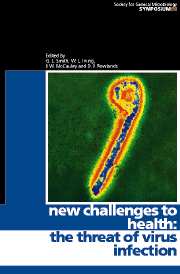Book contents
- Frontmatter
- Contents
- Contributors
- Editors' Preface
- 1 The viruses in our past, the viruses in our future
- 2 Dynamics and epidemiological impact of microparasites
- 3 The continuing threat of bunyaviruses and hantaviruses
- 4 Calicivirus, myxoma virus and the wild rabbit in Australia: a tale of three invasions
- 5 Potential of influenza A viruses to cause pandemics
- 6 The hepatitis viruses as emerging agents of infectious diseases
- 7 The emergence of human immunodeficiency viruses and AIDS
- 8 Morbilliviruses: dangers old and new
- 9 Structure–function analysis of prion protein
- 10 Endogenous retroviruses and xenotransplantation
- 11 Gammaherpesviral infections and neoplasia in immunocompromised populations
- 12 Structure and function of the proteins of Marburg and Ebola viruses
- 13 Epidemic dengue/dengue haemorrhagic fever as a public health problem in the 21st century
- 14 Borna disease virus – a threat for human mental health?
- 15 Antiviral drug development and the impact of drug resistance
- Index
13 - Epidemic dengue/dengue haemorrhagic fever as a public health problem in the 21st century
Published online by Cambridge University Press: 06 July 2010
- Frontmatter
- Contents
- Contributors
- Editors' Preface
- 1 The viruses in our past, the viruses in our future
- 2 Dynamics and epidemiological impact of microparasites
- 3 The continuing threat of bunyaviruses and hantaviruses
- 4 Calicivirus, myxoma virus and the wild rabbit in Australia: a tale of three invasions
- 5 Potential of influenza A viruses to cause pandemics
- 6 The hepatitis viruses as emerging agents of infectious diseases
- 7 The emergence of human immunodeficiency viruses and AIDS
- 8 Morbilliviruses: dangers old and new
- 9 Structure–function analysis of prion protein
- 10 Endogenous retroviruses and xenotransplantation
- 11 Gammaherpesviral infections and neoplasia in immunocompromised populations
- 12 Structure and function of the proteins of Marburg and Ebola viruses
- 13 Epidemic dengue/dengue haemorrhagic fever as a public health problem in the 21st century
- 14 Borna disease virus – a threat for human mental health?
- 15 Antiviral drug development and the impact of drug resistance
- Index
Summary
INTRODUCTION
There was an unprecedented global resurgence of epidemic dengue fever (DF) in the waning years of the 20th century. Both the viruses and the mosquito vectors expanded their geographic distribution, and there was a dramatic increase in the frequency of epidemic dengue, followed by the emergence of the severe form of disease, dengue haemorrhagic fever (DHF), in most tropical regions of the world (Gubler, 1988, 1997, 1998; Halstead, 1992). An estimated 3 billion people currently live in areas at risk for dengue infection (World Health Organization, 1999) (Fig. 1). Each year there are an estimated 50–100 million cases of the mild disease, DF, and several hundred thousand cases of the severe form of disease, DHF, depending on the epidemic activity that particular year. The case fatality rate of DHF cases averages about 5% (World Health Organization, 1999). In 2001, epidemic DF/DHF is one of the most important emergent tropical infectious diseases in the world, primarily affecting the urban centres of tropical developing countries. This chapter briefly reviews the changing epidemiology of dengue, discusses the factors responsible for the recent resurgence, and reviews options for prevention and control.
NATURAL HISTORY
DF/DHF is caused by infection with dengue viruses. There are four closely related virus serotypes, DEN-1, DEN-2, DEN-3 and DEN-4, which show extensive cross-reactivity in serologic tests, but do not provide cross-protective immunity (World Health Organization, 1997; Gubler, 1998). Thus persons living in an endemic area can be infected with three and probably all four of the dengue serotypes during their lifetime.
- Type
- Chapter
- Information
- New Challenges to HealthThe Threat of Virus Infection, pp. 247 - 268Publisher: Cambridge University PressPrint publication year: 2001



